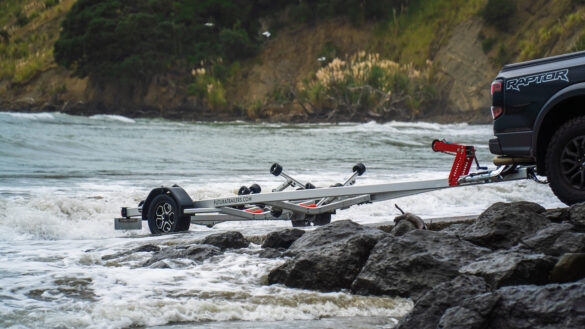A boat trailer is just what it says, a trailer for carrying a boat. That sounds pretty simplistic, but boat trailers are very different to recreational-type garden trailers. Firstly they are going to be dipped into water, for us down under predominantly salt water and that’s just the start of it!
When the first boat trailers were built, they were timber, but soon that changed to metal and common in the earliest years of trailer boats were trailers made from steam pipe. We soon moved on to steel box section that was cut and welded to shape. Today trailers are mostly manufactured from special cut, folded and bent steel sections. Boat trailers are now galvanised to prevent rust, both inside and out. In more recent times, aluminium trailers have increased in popularity.
But it’s not just the frame that has been purpose-built for marine applications; it’s also all the running gear that is trailer boat specific, such as lights, brakes, rollers, pads and winches. Most things on a boat trailer are designed for a purpose, to make towing, retrieving and launching your boat that much easier and safer.
Boat trailers come in a variety of sizes from as little as 3m for small dinghies and PWCs to upwards of 10m for the largest trailer boats. Single, tandem or triple axle, it all depends on what size your boat is.
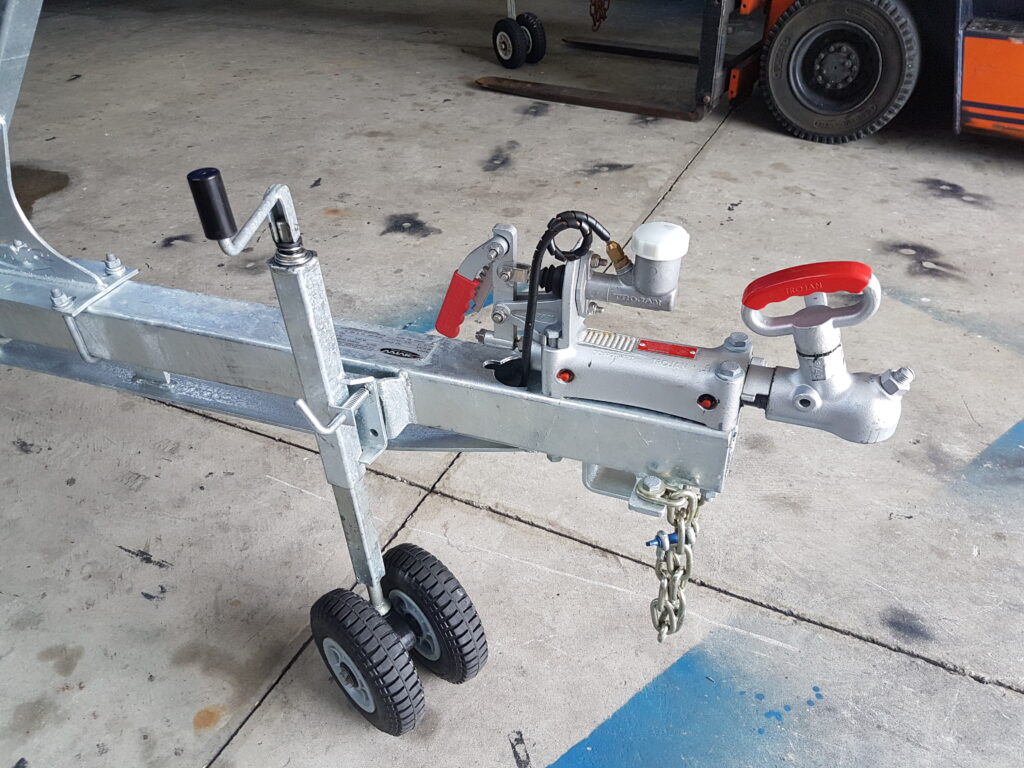
TOWBARS AND COUPLINGS
When you hook your trailer up to your tow vehicle, there are a few things to consider. Firstly how heavy is the rig you are towing and is your vehicle rated to tow it? An average 6m-trailer boat is going to weigh around 2200 kgs all up, boat/motor/trailer, package so this means that a 4cyl family car isn’t going to cut it. You need something bigger such as an SUV or a good-sized six or eightcylinder car.
Moving on up if you are towing a 7m plus boat on the back then you might consider something like a big crew cab ute, most have a towing capacity of 3500 kgs, which is plenty.
Next, you need to check the way the tow bar is attached to the vehicle. Solid mounting points on the subframe are critical and in the case of larger Utes, they are bolted to the chassis. Drilling holes in the boot floor pan is a disaster waiting to happen.
Then there is the tow ball. NZ has a strange system of two standard ball sizes, 1 7/8 and 50mm, plus there are even larger options available. When you hitch the rig up to your tow vehicle, make sure the locking tongue on the coupling engages properly.
Chains are important and you need to make sure you have a quality chain that is bolted (not welded) to the trailer chassis. Certified shackles are also a good insurance.

WINCH POSTS AND WINCHES
The winch post on your trailer is one of the most important components when you consider it not only stops the boat flying forward, the winch mounting point and its position have a lot to do with the way the trailer is balanced. Most mounting posts are attached with heavy-duty U bolts so you can slide it fore and aft to get the balance of the trailer right. This way manufacturers can make one trailer that will fit a variety of designs and sizes, without compromising the integrity of the trailer.
On top of the post is the winch, which is either manual or electric. In the case of the manual winch, various ratios are available so you can winch on big heavy boats, without having to spend a week at the gym. However, if you are planning on something that weighs over 2500 kgs it is recommended to have an electric winch that will do all the pulling for you. These also come in a variety of sizes with various pulling power and can be operated from a separate battery or off a connection to the tow vehicle.
While wire was once the only option, winches are now offered with synthetic rope and web straps, so no more metal strands in the hands when you grab the winch wire. Talking of safety chains, again it is important to have solid chains with rated shackles as this is going to be one of the main anchor points for the boat on the trailer.

TO BRAKE OR NOT TO BRAKE
Boat trailers come with or without brakes. There are two brake systems available, manual override or electric. Trailer brakes are not required up to 750kg and are only recommended from 750- 2000 kg. From 2000–2500 kg you must have override brakes, the most simple system is the manual override brake that is most common on Kiwi trailers. This works on inertia, so when the vehicle is braked the trailer brakes are activated through a hydraulic system. Simple, effective and reasonably foolproof.
However, when you start to tow rigs over 2000kgs, you need to move up to a more serious braking system such as electric over hydraulic, where the system is fully controlled by the braking action of the vehicle.
The most common problem with boat trailers is failed trailer brakes. Because boat trailers are regularly immersed in highly corrosive saltwater, the trailer brakes will corrode and then fail very quickly without regular and constant maintenance. The best preventative maintenance is washing with fresh water every time you use the boat.
Irrespective of the type of brake operating system, you need to examine the brake discs and callipers for corrosion. Also, check that the discs are not warped. A warped disc can be a problem because the braking pressure will be irregular, resulting in heat build-up on the highway, and possible tyre and wheel bearing failure.
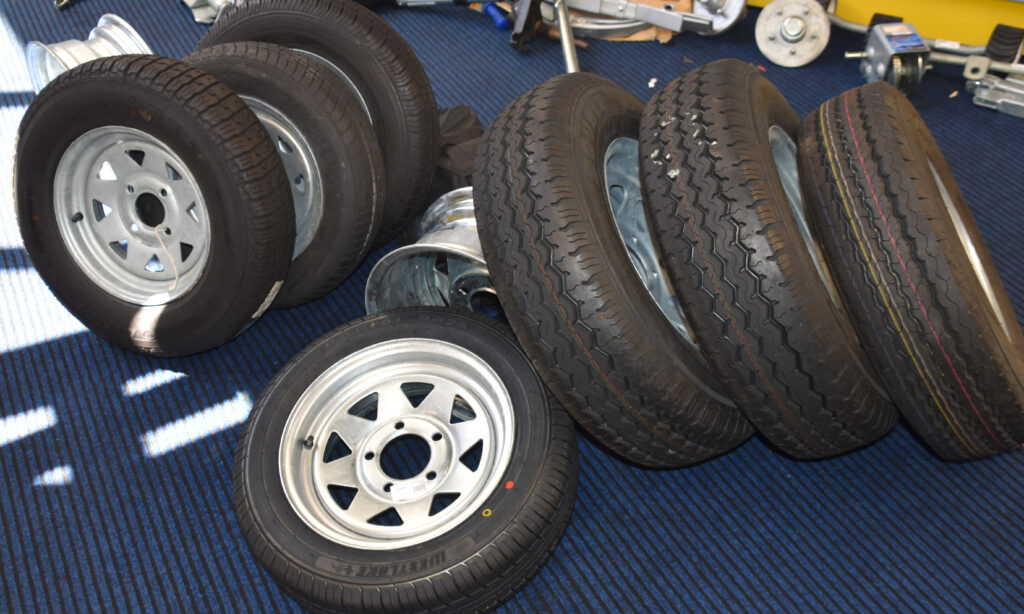
TYRES & SUSPENSION
Okay so the brakes are going to stop you but what about the tyres you have wrapped around them? Too often people put on inferior tyres that will not stand up to the stresses of a boat trailer. Overloaded tyres also commonly cause tyre failure. You may find the trailer itself can handle 1,500kg, but the trailer tyres are only rated for just 1,000kg.
Due to the hard work that a trailer tyre gets, it is recommended to use at least 8-ply light commercial truck tyres and unlike your car, they should be pumped up to high pressures around 44-65 psi. In fact, in some cases double the tyre pressure of your car. However, the rear tyres on your tow vehicle should be pumped up much higher than normal when towing, especially if you have high sidewalls.
Thanks to modern technology, the suspensions, axles and brakes of new trailers can be galvanised for protection against corrosion. Suspensions are common in two basic forms, the regular leaf spring set up or rubber torsion axles, which are made with thick rubber cords concealed in the axle’s tubing. Both do the same job and both are basically trouble-free. With the spring system, you need a full axle across the trailer frame, which can have a bearing on how low you can position your boat. The rubber torsion axle system is based on a drop arm system that is individually mounted on either side and is favoured by those who like to get their deep vee boats as low as practical on the trailer. If you are into shallow water beach launching having a low trailer is a bonus.
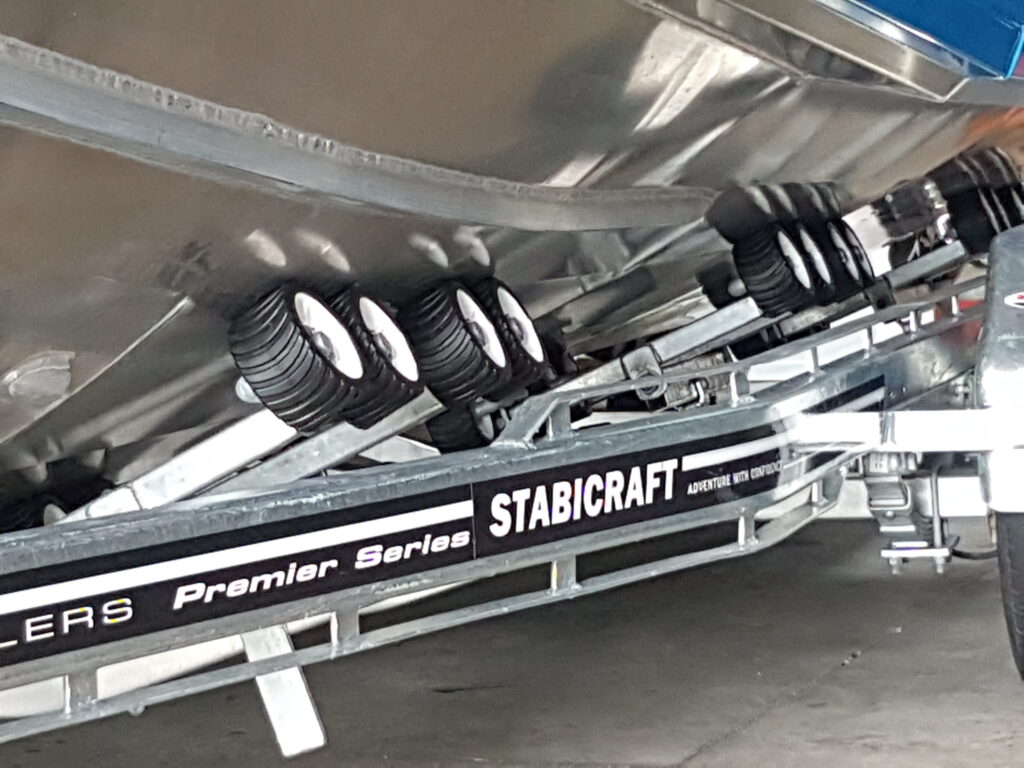
BUNKS OR ROLLERS?
So what’s best? Bunks or rollers. Bunks are very common on imported US-built trailer boats where steep concrete ramps are common and the boats are designed to be more floated on and off the trailer. In New Zealand however, we don’t have the luxury of loads of steep ramps and in many cases with high tide fluctuations, the ramps stop before the deeper water. This means if you have a bunk trailer the difficulty in getting your boat on and off the trailer is worse, especially if you are beach launching like many of us do.
Some people swear by bunk trailers as they feel they disperse the pressure points on the hull more evenly, especially when it comes to aluminium boats and don’t leave any dents on the bottom. We believe if you get dents in the hull because of the rollers, you may need to look for a stronger and better-built boat and trailer. The secret is plenty of rollers to carry the load.
Multi roller trailers are the best for Kiwi conditions that’s for sure, with our launching options. A good multi-roller trailer requires very little effort to launch a boat and if you are too quick and release the safety chain too early, you may well find your boat sitting on the beach or in the shallows.

LIGHTS & TIE DOWNS
Boat trailers are like any trailer they need to be registered and have a current warrant. Part of that warrant is an effective fully operational lighting system. The regulations state that you have to have normal stop, signal and rear trailer lights, and if your trailer package weighs over 2000kgs sidelights are also mandatory.
As the lights are usually mounted at the lowest part of the trailer, they are going to get wet when you back into the water. Hence underwater or fully submersible lights, which are now commonplace. There are several good brands in NZ and Australia that make some of the best in the business and if fitted correctly give very little problem.
Another system is to have a light board that is mounted on the rear of the deck and held in place with bungee cords. The lighting cable runs over the deck through to the back of the tow vehicle. This works well and is perfect for a small trailer or if you want to have a multi-use board for the garden trailer as well. While we are focusing on the back of the trailer, we should mention the tie-downs. These are very important and if you are driving anywhere, you should have them attached. They are one of three security fittings for the boat, the other being the winch wire with the safety chain and will also stop the boat from bouncing up and down, or even off while being towed.
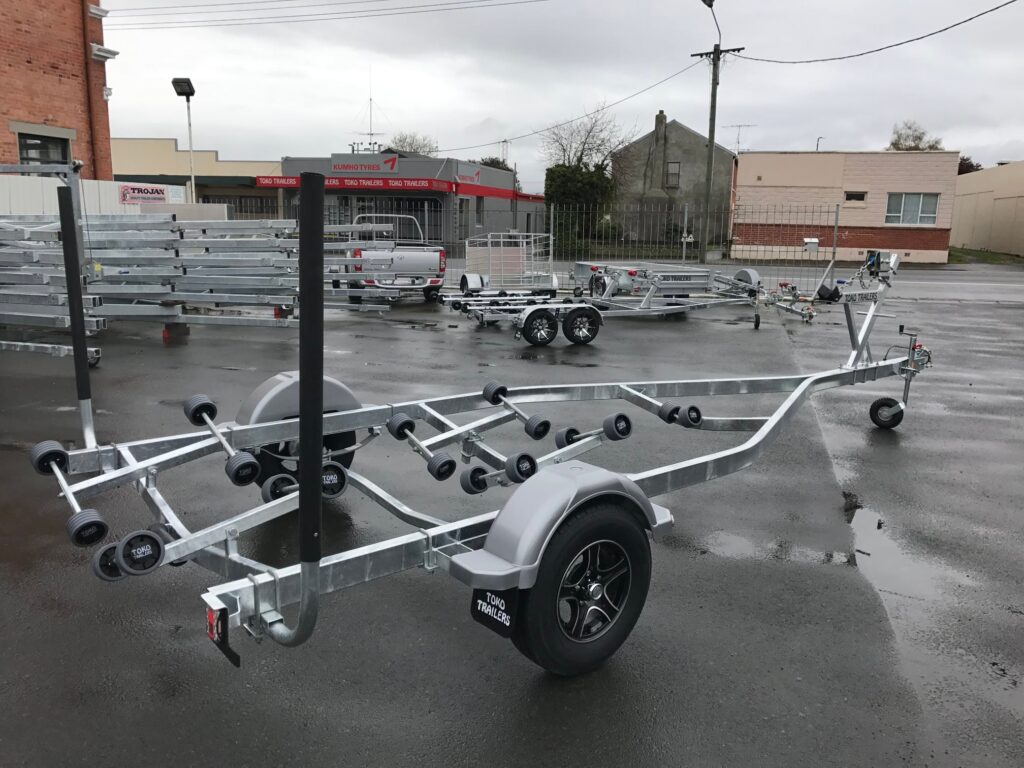
PURCHASING A TRAILER
Some tips when choosing a manufacturer:
- Quality Assurance: Look for manufacturers with a reputation for high-quality materials and craftsmanship.
- Customisation Options: Consider your specific boat and trailer needs; choose a manufacturer that offers some customisation.
- Customer Reviews: Check customer reviews and testimonials to gauge satisfaction with product quality and after-sales service.
- Warranty and Support: Ensure the manufacturer provides a warranty and has a reliable support system for maintenance and repairs.
Several manufacturers in New Zealand and Australia represent some of the top choices for boat trailers, each offering different strengths in terms of customisation, durability, and customer service. When choosing a trailer, consider your boat’s specifications and your intended use to find the best fit for your needs, and most of all stay safe when towing your rig!


